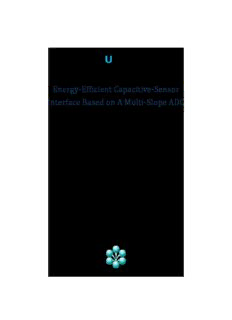Table Of ContentEnergy-Efficient Capacitive-Sensor
Interface Based on A Multi-Slope ADC
Yao Cheng
4123735
Supervisor: Dr. S. Nihtianov
Submission to
The Faculty of Electrical Engineering,
Mathematics and Computer Science
in Partial Fulfillment of the requirements
for the degree of
Master of Science
In Electrical Engineering
Delft University of Technology
September 2012
Committee members:
Dr. S. Nihtianov ( TU Delft: Electronic Instrumentation Laboratory )
Dr. ir. R. F. Wolffenbuttel ( TU Delft: Electronic Instrumentation Laboratory )
Dr. L. C. N. deVreede ( TU Delft: Electronics Research Laboratory )
Dr. ing. M. Spirito ( TU Delft: Electronics Research Laboratory )
Acknowledgements
I wish to express my deepest appreciation to my supervisor Dr. Stoyan Nihtianov
for his brilliant ideas, insightful supervision and proof-reading my thesis. Without
him, I think I was an amateur, who does not have experience in research, IC design
one year ago at Delft University. I really appreciate his time and dedication which
he had put in training me and shaping my career as an engineer. This project was
impossible without his support.
I wish to express my thanks to Dr. Roumen Nojdelov for providing the test board of
my chip and all the helpful related information. I would like to thank him for his
full support and the useful feedback in this project.
I am thankful to other defense committee members who read my thesis.
I would like to thank all the people in the group for giving their valuable feedback
and suggestions on my thesis, especially Zu-yao Chang for helping me with the
measurements, devices and equipment, and Ruimin Yang for explaining me various
things related to the project.
I want to thank my colleagues in EI laboratory for all the help. It was really a
pleasure to work in EI lab.
I would also like to thank all the people in my office for all the nice help and
chatting, especially Kia, Yuxin Yan for sharing their knowledge.
i
Acknowledgements
I would also like to thank Xiaoyan Pang, who seems like my sister in the
Netherlands; and Xuexue Chen for her selfless supporting.
Thanks to my friends Yang Li, Yang Liu, Xiaoliang Ge, Jianghai He, Ruoshi Wang,
Yating Ren, Qing Wang, Yingjiao Li, Xu Wang, Wenbo Zhao, Donghua Zhang,
Shuang Deng, Yan Yang, Xinqian Fan, Lipu Fei, Javier, Anduew, Rong Fan, Hang
Ma and many more friends for their understanding, support and help in my life.
Thanks to all my teachers for dedicating their knowledge and teaching me to
become a useful person.
My forever thanks to my parents for their uncountable sacrifices, understanding,
encouragement and support. I do appreciate their love and I will requite their love
in my entire life.
Lastly, I want to thank anyone who helped me in any way during this project who
due to my weak memory I did not mention here. My apologies to all of them.
ii
Abstract
This thesis presents an energy-efficient capacitive sensor interface based on a
multi-slope analog-to-digital converter (ADC). This highly stable capacitance-to-
digital converter (CDC) utilizes precision resistor as reference components. By
utilizing a multi-slope analog-to-digital converter, the conversion time of this
design is reduced down to 50us. The counter works as a sinc filter to reduce the
noise, which helps to achieve a resolution of 15 bits with a 0.2W power
consumption.
Keywords – Capacitance-to-digital converter, multislope analog-to-digital
converter, precision resistor, sinc filter.
iii
Abstract
iv
Contents
Introduction ................................................................................................................. 1
1.1 Capacitive Sensors .................................................................................................... 2
1.1.1 Measurement Principles ..................................................................................... 3
1.2 Readout Approaches ................................................................................................. 5
1.2.1 First Order Relaxation Oscillator ....................................................................... 5
1.2.2 Sigma-Delta AD converter ................................................................................ 6
1.2.3 Multi Slope AD converter ................................................................................ 10
1.2.4 Comparison and Final solution ........................................................................ 15
1.3 Organization of the Thesis ...................................................................................... 15
Architecture-level Analysis and Design .................................................................. 17
2.1 Target Specifications .............................................................................................. 17
2.2 Existing CDC Principle........................................................................................... 18
2.2.1 Operating Principle .......................................................................................... 18
2.2.2 Timing Diagram ............................................................................................... 19
2.3 Operating Principles................................................................................................ 21
2.3.1 Front-end Operation ......................................................................................... 22
2.3.2 Discharging Operation ..................................................................................... 24
2.3.3 Comparator and Counting Operation ............................................................... 26
2.4 Error analysis .......................................................................................................... 26
v
Contents
2.4.1 Thermal noise................................................................................................... 26
2.4.2 Quantization noise ........................................................................................... 28
2.4.3 Flicker noise and Offset ................................................................................... 28
2.4.4 Digital Filtering ................................................................................................ 29
2.4.5 Comparator Delay ............................................................................................ 29
2.5 Measuring Modes.................................................................................................... 30
2.5.1 Measuring Mode 1 ........................................................................................... 30
2.5.2 Measuring Mode 2 ........................................................................................... 32
2.5.3 Measuring Mode 3 ........................................................................................... 33
2.6 Conclusions ............................................................................................................. 35
Circuit-level Analysis and Design ............................................................................ 37
3.1 Op-Amp Design ...................................................................................................... 37
3.1.1 Specifications ................................................................................................... 37
3.1.2 Design Approach ............................................................................................. 41
3.1.3 Operational Amplifier Design.......................................................................... 42
3.2 Comparator Design ................................................................................................. 45
3.3 Switch Design ......................................................................................................... 47
3.4 Simulation Results .................................................................................................. 49
3.4.1 Op-Amp ........................................................................................................... 50
3.4.2 Comparator ...................................................................................................... 52
3.5 Conclusions ............................................................................................................. 53
Measurement Results ................................................................................................ 57
4.1 Fabricated chip ........................................................................................................ 57
4.1.1 Circuit layout ................................................................................................... 57
vi
Contents
4.1.2 Chip micrograph .............................................................................................. 59
4.2 Measurement setup ................................................................................................. 59
4.2.1 Printed Circuit Board (PCB) Design................................................................ 60
4.2.2 Equipment ........................................................................................................ 62
4.3 Experimental Results .............................................................................................. 63
4.3.1 Signal to Noise Ratio ....................................................................................... 63
4.3.2 Temperature Stability....................................................................................... 64
4.3.3 Power Consumption ......................................................................................... 67
4.4 Conclusions ............................................................................................................. 67
Conclusions ................................................................................................................ 69
5.1 General Conclusions ............................................................................................... 69
5.2 Main Contributions ................................................................................................. 70
5.3 Future work ............................................................................................................. 71
Appendix A …………………………………………………………………… 73
vii
Contents
viii
Description:utilizing a multi-slope analog-to-digital converter, the conversion time of this design is reduced down to 50us Circuit-level Analysis and Design .

